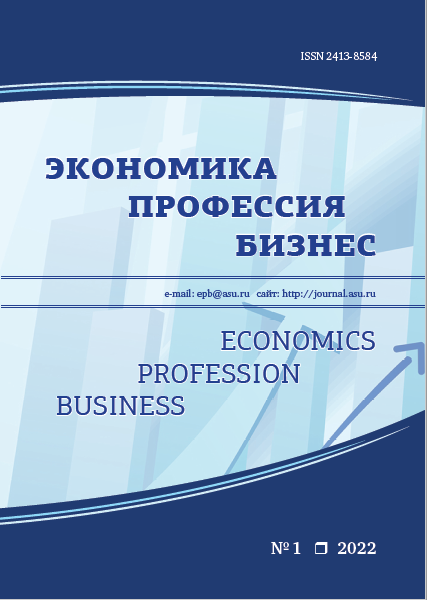ASSESSMENT OF PROFITABILITY AND TAX BURDEN OF AGRICULTURAL ENTERPRISES AS PART OF AGRICULTURAL HOLDINGS
УДК 338.314:336.22:631.14
Abstract
The purpose of the study was to identify the differentiation of profitability and tax burden of legally independent agricultural organizations and organizations within agricultural holdings, as well as to determine the influence of a number of factors on the change in profitability and the level of tax burden. The article analyzes the dynamics of profitability and tax payments of agricultural organizations of the Altai Territory. During the research, data on the amount of taxes, fees and insurance payments paid by agricultural enterprises of the Altai Territory, depending on their membership in agricultural holdings, were summarized, and an assessment of the tax burden of these enterprises was given. It is established that the tax burden of agricultural organizations that are part of agricultural holdings is higher than the tax burden of legally autonomous organizations, which is primarily due to the specialization of economic entities. The profitability of agricultural enterprises’ production was also determined by the structure of their marketable products. It is noted that the revenue and the amount of taxes and fees to varying degrees have an impact on the tax burden of organizations that are part of agricultural holdings and legally autonomous enterprises.
Downloads
Metrics
References
Цапулина Ф. Х., Казакова Н. Ю., Герасимова И. Н. О проблемах налоговой политики агропромышленного комплекса России // Фундаментальные исследования. 2016. № 11-3. С. 662-667.
Рябинина Н. И., Туранцева Н. А. Особенности налогообложения предприятий АПК и налоговые риски сельхозпроизводителей в России // Экономика, предпринимательство и право. 2018. Т. 8. № 4. С. 203212.
Тихонова А. В. Налоговое регулирование аграрного сектора: оценка и проблематика // Известия Иркутской государственной экономической академии. 2014. № 6. С. 25-34.
Кожевников Е. Б., Осадчая О. П. Методические аспекты определения налоговой нагрузки на интегрированную бизнес-структуру // Известия Алтайского государственного университета. 2011. № 2-2. С. 292-296.
Шагайда Н. И. Интеграция сельского хозяйства в продовольственные цепочки: российская практика и международный опыт (экспертная дискуссия) // Экономика сельскохозяйственных и перерабатывающих предприятий. 2015. №3. С.17-22.
Воробьев С. П., Гриценко Г. М., Воробьева В. В. Особенности формирования и реализации экономических интересов в сельском хозяйстве // Аграрная наука Евро-Северо-Востока. 2017. № 6. С. 78-83.
Крупнейшие владельцы сельскохозяйственной земли в России на 2021 год. URL: https://www.befl.ru/news/detail.php?ID=1246/ (дата обращения: 04.11.2021).
Доклад о ходе и результатах реализации в 2020 году государственных программ в сфере развития сельского хозяйства и сельских территорий Алтайского края. URL: https://www.altagro22.ru/activity/analytics/ (дата обращения: 06.11.2021).
Налоговый паспорт субъекта РФ. URL: https://analytic.nalog.ru/portal/index.ru-RU.htm/ (дата обращения: 06.11.2021).
REFERENCES
Gashenko I. V., Orobinskaya I. V. ^am^ristics of tax regulation of the activity of integrated units of the agro-industrial complex in the central black earth region // Regional Economics: Theory and Practice. 2015. No. 26. Pp. 37-50.
Tsapulina F. Kh., Kazakova N. Yu., Gerasimova I. N. About problems of tax policy of agroindustrial complex of Russia // Fundamental research. 2016. No. 11-3. Pp. 662-667.
Ryabinina N. I., Turantseva N. A. Features of taxation of agricultural enterprises and tax risks of agricultural producers in Russia // Journal of economics, entrepreneurship and law. 2018. Vol. 8. No. 4. Pp. 203-212.
Tikhonova A. V. Agricultural sector tax regulation: evaluation and problems // Bulletin of Baikal state university. 2014. No. 6. Pp. 25-34.
Kozhevnikov E. B., Osadchaya O. P. Methods to determine tax load on integrated business-structure // Izvestiya of Altai State University. 2011. No. 2-2. Pp. 292-296.
Shagaida N. I. Integration of agriculture in food chains: russian practice and world experience (expert discussion) // Economy of agricultural and processing enterprises. 2015. No. 3. Pp. 17-22.
Vorobyov S. P., Gritsenko G. M., Vorobyova V. V. Features of formation and realization of the economic interests in agriculture // Agricultural science Euro-North-East. 2017. No. 6. Рр. 78-83.
The largest owners of agricultural land in Russia for 2021. URL: https://www.befl.ru/news/detail.php?ID=1246/ (date of access: 04.11.2021).
Report on the progress and results of the implementation in 2020 of state programs in the field of development of agriculture and rural territories of the Altai Territory. URL: https://www.altagro22.ru/activity/analytics/ (date of access: 06.11.2021).
Tax passport of the subject of the Russian Federation. URL: https://analytic.nalog.ru/portal/index.ru-RU.htm/ (date of access: 06.11.2021).
Economics Profession Business is a golden publisher, as we allow self-archiving, but most importantly we are fully transparent about your rights.
Authors may present and discuss their findings ahead of publication: at biological or scientific conferences, on preprint servers, in public databases, and in blogs, wikis, tweets, and other informal communication channels.
Economics Profession Business (EPB) allows authors to deposit manuscripts (currently under review or those for intended submission to EPB) in non-commercial, pre-print servers such as ArXiv.
Authors who publish with this journal agree to the following terms:
- Authors retain copyright and grant the journal right of first publication with the work simultaneously licensed under a Creative Commons Attribution License that allows others to share the work with an acknowledgement of the work's authorship and initial publication in this journal.
- Authors are able to enter into separate, additional contractual arrangements for the non-exclusive distribution of the journal's published version of the work (e.g., post it to an institutional repository or publish it in a book), with an acknowledgement of its initial publication in this journal.
- Authors are permitted and encouraged to post their work online (e.g., in institutional repositories or on their website) prior to and during the submission process, as it can lead to productive exchanges, as well as earlier and greater citation of published work (See The Effect of Open Access).









